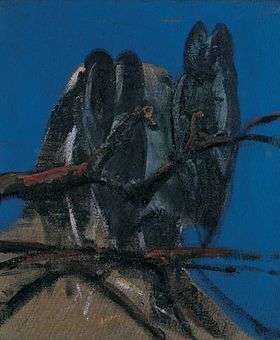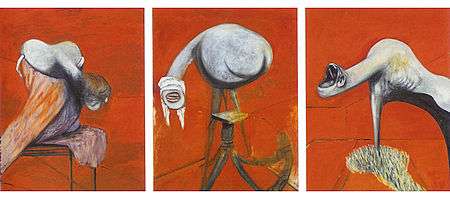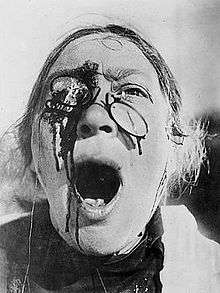Fragment of a Crucifixion
 | |
| Artist | Francis Bacon |
|---|---|
| Year | 1950 |
| Type | Oil and cotton wool on canvas[1] |
| Dimensions | 140 cm × 108.5 cm (55 in × 42.7 in) |
| Location | Stedelijk Van Abbemuseum, Eindhoven |
Fragment of a Crucifixion is a 1950 painting by Irish-born artist Francis Bacon and one of his many works based on iconography of the Crucifixion of Jesus. Its shows two distressed figures at the end of a bloody struggle, one is positioned at the point of kill; the other dying animal's scream forms the centerpiece of the work, and can be compared to Bacon's later, more famous, screaming Popes series. Although the painting's title contains religious connotations, Bacon was an atheist and there is no hope for divinity or afterlife in the work. Instead, it represents what he saw as the hopelessness and endless struggle of the human condition.[2]
A muscular male dog stoops on a horizontal beam that forms part of a T-shaped structure intended to both signify Christ's cross and indicate a beam hanging over a door. An apparently female chimera is trapped within this frame, and is powerless in the course of being mutilated by the dog. Blood pours from the canine's mouth onto the head and body of his prey, who is rendered as owl-like but with human facial characteristics.
Typical of Bacon's work, the painting is drawn from a wide variety of sources, including the scream of the nurse in Sergei Eisenstein's 1925 silent film "The Battleship Potemkin",[3] photographs of Adolf Eichmann, and many depictions of the biblical crucifixion and the lowering of the dead Christ from the Cross.
Description
The two figures are positioned in the center foreground of the canvas. Although both are mutilated and covered in blood, their physical discomfort is contrasted against a tranquil and flat, warm background typical of Bacon's work from this period. The figures exhibit many elements typical of Bacon's early work, most noticeably the expressive broad strokes, which are set in contrast against the tightness of the flat, unmemorable, background. The painting contains the same white angular rails Bacon had inserted into the mid-ground of his 1949 Head II and Head IV, as well as the Study for Portrait of the same year. In Fragment..., the rails are positioned just below the area where the horizontal and vertical bars of the cross intersect. The rail begins with a diagonal line which intersects the owl at what appears to be the creature's shoulder.[3]
A horizontal angular geometrical shape is sketched in white and grey in the mid-ground, and represents an early form of a spatial device Bacon was to develop and perfect over the course of the 1950s, when it effectively became a cage used to frame the anguished figures portrayed in Bacon's foregrounds.[3][4][5] The body of the fleshy part-bird [6] chimera is rendered with light paint, and from it hang narrow red drips of paint, indicating the drips and spatter of blood. Pentimenti is used to convey the blood of the death throes the figures have brought to each other.[3] The link with the biblical Crucifixion is made through the raised arms of the lower creature and the T shaped cross.[7] While the upper creature is obviously modelled on a dog,[8] it seems likely that the chimera is based on pictures of bats Bacon kept in his private collection of images.[9] The lower figure's human aspect is seen most notably in the details of its mouth and genitalia.
In the mid-ground, the artist has sketched a street scene, which features a number of walking figures and cars. The pedestrians appear unaffected and uninterested in the slaughter before them.
Relationship with Bacon's other paintings
The painting has been linked both thematically and its formal construction to the 1956 work Owls and to a number of preparatory sketches only brought to the art market in the late 1990s.[10] Zweite traces the origin of the lower figure to a photograph of an owl Bacon found in a book on birds in motion. However, Bacon has replaced the bird's beak with a wide open human mouth.[11]

Fragment is one of a number of treatments Bacon created to examine the biblical crucifixion scene. Here again, he incorporates Greek legend into his treatment of the crucifixion, notably the tale of Aeschylus and the Eumenides—or Furies—found in The Oresteia, which is referenced by the broad wings of the chimera.

Bacon's imagery became less extreme and more imbued with pathos as he got older, and less and less of his canvases contained the sensational imagery that had made him famous in the mid-1940s. He said, "When I was younger, I needed extreme subject-matter. Now I don't." According to the art critic John Russell, Bacon found it more powerful to reflect violence in his brush strokes and colourisation, not literally, and not "in the thing portrayed".[12]
Bacon was his own harshest critic, and often both destroyed or disowned certain works that yet were held in high regard by critics and buyers. Fragment of a Crucifixion is one he came to dislike; he viewed it as too explicit, in the words of Russell, "too near the conventions of narrative-painting."[12][13]
Imagery and sources
The Crucifixion
The title of Fragment of a Crucifixion refers to Christian iconography, while the T-shaped Crux Commissa is intended to indicate the cross of Saint Anthony.[11] Crucifixion scenes can be found in Bacon's earliest works,[14] and the imagery of the crucifixion weights heavily throughout his career. The critic John Russell wrote that the crucifixion in Bacon's work is a "generic name for an environment in which bodily harm is done to one or more persons and one or more other persons gather to watch".[15]
.jpg)
In 1933, the artist's patron Eric Hall commissioned a series of three paintings based on the subject.[17] These early paintings were influenced by such old masters as Matthias Grünewald, Diego Velázquez and Rembrandt,[14] but also by Picasso's late 1920s and early 1930s biomorphs[18] and the early work of the Surrealists.[19] Bacon admitted that he saw the scene as "a magnificent armature on which you can hang all types of feeling and sensation".[20] He believed that the imagery of the crucifixion allowed him to examine "certain areas of human behaviour" in a unique way, as the armature of the theme had been accumulated by so many old masters.[20] In Fragment, Bacon refers to the descent of the cross, and links have been made to both Matthias Grünewald and Peter Paul Rubens's works on this subject.[21]
According to the art critic Hugh Davies, "The open mouth of the terrified victim, the T-Shape of the cross, and the figure leaning over the crossbar link Bacon's painting with Rubens' Descent of the Cross in London. But the mouth loosely opened in seventeenth century painting is taut in Bacon's image. The legs folded out of view and the left arm passively by Rubens are transposed by Bacon into violent motion, flopping wildly up and down."[21]
Horizontal lines

These horizontal frames were to become a major motif of his works in the later 1950s, and in the Fragment of a Crucifixion he hints at their later form as triangles in works such as the 1970 Three Studies of the Male Back. These frames were at the time being incorporated into other contemporary paintings, having been developed by sculptors such as Henry Moore and Alberto Giacometti. Giacometti had employed the device in his The Nose (1947) and The Cage (1950), while Moore had used the frame in his 1952 Maquette for King and Queen.[5]

Bacon's use of these frames has brought to mind imprisonment with many critics, and Adolf Eichmann's glass cage during his 1961 trial is a common reference.[22][23] Writing on their use in Fragment, the art critic Armin Zweite wrote that the diagonal lines, on the one hand point inwards towards the idyll, in a promise of happiness, on the other they transform the cross into a guillotine and suggest misfortune. The situation is double-edged, a Damocles. If you want to reach the "good world" you have to pass through the "bad world", and you run the risk of being killed in the process.[3]
The open mouth
The inspiration for the recurring motif of the screaming mouths in many Bacon's work from the late 1940s and early 1950s was drawn from a number of sources, including medical text books, the works of Matthias Grünewald[24] and photographic stills of the nurse in the Odessa Steps sequence in Sergei Eisenstein's 1925 silent The Battleship Potemkin. Bacon first saw the film in 1935 and viewed it frequently thereafter. He kept a photographic still of the scene in his studio, which showed a close-up of the nurse's head screaming in panic and terror and with broken pince-nez spectacles hanging from her blood stained face. He referred to the image in paintings throughout his career.[25]
By the early 1950s, it had become an obsessive motif, to the point, according to art critic and Bacon biographer Michael Peppiatt, that "it would be no exaggeration to say that, if one could really explain the origins and implications of this scream, one would be far closer to understanding the whole art of Francis Bacon."[26] In this work the scream of the owl-like figure trapped in the chimera jaws reiterates the motif.
Notes
- ↑ Peppiatt, 92
- ↑ Davis, 404
- 1 2 3 4 5 6 Zweite, 114
- ↑ Rothenstein, John. "Francis Bacon: Exhibition Cath." Tate Gallery, 23 May-1 July 1962
- 1 2 Sylvester, 36
- ↑ Gale, Matthew. "Three Studies for Figures at the Base of a Crucifixion". Tate. Retrieved on 18 April 2009.
- ↑ van Alphen, 91
- ↑ The Tate suggest it may have been modelled on a cat. See Gale, 1998
- ↑ Sylvester, 40
- 1 2 Gale, Matthew. "Two Owls, No. 2 circa 1957-61". Tate, February 1999. Retrieved on March 30, 2009.
- 1 2 3 Zweite, 85
- 1 2 Russell, 76
- ↑ Schmied, 75
- 1 2 Sylvester, 13
- ↑ Russell, 113
- ↑ Rothenstine; Alley, 28
- ↑ Davies & Yard, 12
- ↑ Baldassari, Anne. Bacon and Picasso. Paris: Flammarion, 2005. 140-144. ISBN 2-08-030486-0
- ↑ Bürger, Peter. In Zweite, 30
- 1 2 Schmied, 78
- 1 2 Adams, 179
- ↑ Sylvester, 37
- ↑ Farr, 60
- ↑ Schmied, 73
- ↑ Davies
- ↑ Peppiatt, 24
Sources
- Adams, James Luther & Yates, Wilson & Warren, Robert. The grotesque in art and literature . Grand Rapids, Michigan: William B Eerdmans Publishing, 1997. ISBN 0-8028-4267-4
- Alley, Ronald & Alley, John. Francis Bacon. London: Thames & Hudson, 1964. ASIN B001AG7U1K
- Davis, Stephen T.The Incarnation: An Interdisciplinary Symposium on the Incarnation of the Son of God. Oxford: Oxford University Press, 2002
- Murray, Gilbert. Agamemnon in Complete Plays of Aeschylus. London: George Allen & Unwin, 1952. 86
- Peppiatt, Michael. Francis Bacon in the 1950s. Yale: Yale University Press, 2006. ISBN 0-300-12192-X
- Russell, John. Francis Bacon. London: Thames & Hudson, 19. ISBN 0-500-20271-0
- Schmied, Wieland. Francis Bacon: Commitment and Conflict. Munich: Prestel, 1996. ISBN 3-7913-1664-8
- Sylvester, David. Looking back at Francis Bacon. London: Thames and Hudson, 2000. ISBN 0-500-01994-0
- van Alphen, Ernst. Francis Bacon and the loss of self. Chicago: Reaktion Books, 1992. ISBN 0-948462-34-5
- Zweite, Armin. The Violence of the Real. London: Thames and Hudson, 2006. ISBN 0-500-09335-0